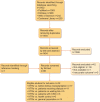Mapping health-related quality of life after kidney transplantation by group comparisons: a systematic review
- PMID: 34338799
- PMCID: PMC8643597
- DOI: 10.1093/ndt/gfab232
Mapping health-related quality of life after kidney transplantation by group comparisons: a systematic review
Abstract
Background: Health-related quality of life (HRQOL) is becoming an increasingly important outcome in kidney transplantation (KT). To describe HRQOL in kidney transplant recipients (KTRs), this systematic review summarizes literature that compared HRQOL among KTRs and other relevant populations [i.e. patients receiving dialysis, patients on the waiting list (WL) for KT, patients with chronic kidney disease (CKD) not receiving renal replacement therapy (RRT), the general population (GP) and healthy controls (HCs)] and themselves before KT.
Methods: The literature search was conducted in PubMed, Embase, Web of Science and the Cochrane Library. Eligible studies published between January 2000 and October 2020 were included.
Results: Forty-four studies comprising 6929 KTRs were included in this systematic review. Despite the study heterogeneity, KTRs reported a higher HRQOL after KT compared with pre-transplantation and compared with patients receiving dialysis with or without being on the WL, especially in disease-specific domains (i.e. burden and effects of kidney disease). Additionally, KTRs had similar to marginally higher HRQOL compared with patients with CKD Stages 3-5 not receiving RRT. When compared with HCs or the GP, KTRs reported similar HRQOL in the first 1 or 2 years after KT and lower physical HRQOL and lower to comparable mental HRQOL in studies with longer post-transplant time.
Conclusions: The available evidence suggests that HRQOL improves after KT and can be restored to but not always maintained at pre-CKD HRQOL levels. Future studies investigating intervention targets to improve or maintain post-transplant HRQOL are needed.
Keywords: adult; dialysis; health-related quality of life; kidney transplantation; waiting list.
© The Author(s) 2021. Published by Oxford University Press on behalf of ERA.
Figures


References
-
- Jensen CE, Sorensen P, Petersen KD.. In Denmark kidney transplantation is more cost-effective than dialysis. Dan Med J 2014; 61: A4796. - PubMed
-
- Coemans M, Süsal C, Döhler Bet al. . Analyses of the short- and long-term graft survival after kidney transplantation in Europe between 1986 and 2015. Kidney Int 2018; 94: 964–973 - PubMed
-
- Wang JH, Skeans MA, Israni AK.. Current status of kidney transplant outcomes: dying to survive. Adv Chronic Kidney Dis 2016; 23: 281–286 - PubMed
-
- Katabathina V, Menias CO, Pickhardt Pet al. . Complications of immunosuppressive therapy in solid organ transplantation. Radiol Clin North Am 2016; 54: 303–319 - PubMed
Publication types
MeSH terms
LinkOut - more resources
Full Text Sources
Medical

